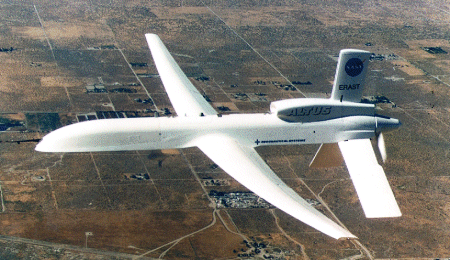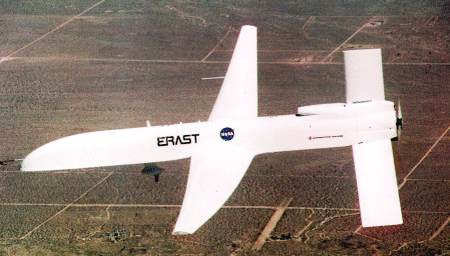Guy Norris/LOS ANGELES

As shopping expeditions go, visiting NASA's display of Environmental Research Aircraft and Sensor Technology (ERAST) project aircraft on 13 October has to rank as one of the strangest. On show, under the appropriate banner of "ready for business", were five of the oddest aircraft ever to grace the ramp at NASA's Dryden Flight Research Center on Edwards AFB, California.
In contrast with the obvious utility of conventional aircraft, the ungainly and fragile looking ERAST vehicles could be a tough sell - as NASA readily admits. "We're inviting science people and some potential customers to go out there and touch them, feel them, see some of them fly. We want to reassure them that they can put their expensive scientific instruments, or 'babies', on them, and they will return safely," says John Del Frate, project manager for the ERAST solar-powered aircraft. "I'd love it if someone was to call me up and say 'I need this mission doing. What sort of aircraft could I have?'."
The event also marks a significant in the five-year-old ERAST project, which was first intended to develop technologies for a new family of remotely piloted vehicles (RPVs) for environmental research. Performance goals for the aircraft were extraordinarily ambitious: speeds as slow as 13kt (24km/h), altitudes up to 100,000ft (30km) and an endurance of up to 96h. With these goals well on the way to being met, the RVPs' commercial and scientific applications are becoming the ERAST project's primary focus.
NASA and the industrial partners in the project believe the long-duration, high-altitude aircraft that come out of ERAST will be uniquely capable of missions that are impossible or prohibitively expensive to achieve. These range from upper atmospheric science missions to help collect, identify and monitor environmental data affecting the global climate, to carrying telecommunication equipment to high altitudes to act as "atmospheric satellites".
Other potential uses include low-cost surveillance and wide area coverage for applications as diverse as tracking packages or stolen vehicles. Together with goals to extend endurance and payload capacity, ERAST maintains a desired cost objective of around $5,000 per flight hour, or a fraction of the cost of rival air and space platforms.
Getting to the point of offering the services of the ERAST platforms for "real" missions has been a combined effort of the project partners. NASA Dryden, which leads the effort, is supported by NASA's Glenn Research Center, which is developing propulsion concepts and heat transfer technology. NASA Langley is overseeing structures research and systems analysis, while NASA Ames is focused on sensor technology and systems analysis. Industrial partners include AeroVironment, of California, makers of the Pathfinder, Centurion and Helios solar-powered ERAST aircraft; Aurora Flight Sciences of Virginia, which made the Perseus A and B vehicles; and General Atomics Aeronautical Systems, which developed the Altus I and II. Scaled Composites has also contributed as a major partner, having developed first the unmanned Demonstrator 2 (D-2) and later the manned Proteus through funding from Angel Technologies.
Other alliance partners include the Virginia-based Association for Unmanned Vehicle Systems International and a raft of California-based companies, including American Technology Alliances, Longitude 112 West, Thermo Mechanical Systems, Advanced Soaring Concepts and Hyperspectral Science.
By broad agreement, the most revolutionary aspect of the ERAST project is the rapid development of the solar-powered flying wing vehicles by NASA and AeroVironment. Emerging from the classified ballistic missile defence programmes in the early 1990s, the flimsy looking flying wings have made dramatic steps towards longer endurance, high altitude operations. "In 1994, it could barely fly a few thousand feet off the ground," recalls Del Frate. "People were saying it wasn't viable, and even the AeroVironment team wondered if they were doing the right thing. Now it is really showing great potential and, in my mind, that aircraft could revolutionise the satellite industry."
Handling the weather
Starting in 1995 with a modified version of the Pathfinder (the original flying wing design), AeroVironment reached 55,500ft with the new variant. "We learned new things about how to handle the weather and how to control a flying wing at very high altitude," says Del Frate. A key lesson from this early period was that the craft was not as fragile as it looked, and tended to flex with the turbulent air like an air mattress on the surface of the sea. In 1997, the solar array was upgraded to provide more electrical power to the aircraft's motors. With more power available, the aircraft was flown to 71,500ft that year.
Dramatic changes followed in 1998 when the Centurion entered the project. Aimed at the more ambitious altitude target of 100,000ft, it was built on the design principles of the Pathfinder but incorporated an extended centre section, higher performance solar cells and a stronger, enlarged structure. The span was extended to 63m (206ft) and the payload capability was increased to 270kg (595lb). The first flight was made on 10 November last year with battery power alone (to reduce expense and risk). The Centurion was powered by 14 brushless DC-electric motors and, including payload, had a maximum gross take-off weight of around 820kg. After three low-altitude test flights, all completed successfully, the team aimed its sights even higher and elected to upgrade the Centurion to an even larger vehicle called the Helios Prototype.

The Helios has a wingspan of 75.3m - 12.5m longer than the Centurion - and was enlarged with the addition of a sixth wing section and a fifth gear pod. Helios was fitted with an extensive turbulence monitoring system to record loads on the structure, as well as a global navigation system for improved navigation. Radiator plates were added to improve heat dissipation.
Flights began at Dryden on 8 September, although the first sortie was cut short by an unexpected battery problem. The first phase of flight tests will be aimed at building to a sustained flight at 100,000ft in 2001. A second phase, using only eight engines but with up to 230kg in ballast to represent an innovative energy storage system being developed, will follow in 2003. This will be aimed at a mission at 50,000ft, lasting up to four days. The energy storage system will ultimately power the electric motors at nighttime, when the solar cells are unable to function. In daylight, excess energy from the cells will be siphoned off and stored in the system for later use.

NASA and AeroVironment hope that scientific and commercial opportunities for Helios will lead to a "relatively large" production run which, in turn, will help drive down the price of the expensive solar cells. NASA sees the high-altitude Helios as the perfect "sentinel" vehicle, able to patrol for months at a time high over the Pacific, Atlantic or even over cities and deserts. The sentinels are expected to be used as relays to help guide other cargo-carrying unmanned air vehicles (UAVs), or alternatively, as monitoring platforms for earth or atmospheric sensors.
Altus, Perseus and Proteus
While the solar-powered vehicles made their first tentative flights, a series of more conventional UAVs made rapid progress. The Altus (below), made by San Diego-based General Atomics Aeronautical Systems, drew heavily on the company's experience in making the Predator an operational military UAV.

Although originally tailored towards commercial communications relay uses, the ERAST project gave General Atomics a chance to see the Altus developed for scientific research projects. This came to fruition when the Altus took part in atmospheric research flights over Hawaii sponsored by the US Department of Energy and supported by NASA.
The aircraft's Rotax 914 engine was modified with a twin turbocharger to improve performance. Meanwhile, endurance limitations pushed the company towards development of an upgraded Predator B. The latter has since been redirected towards military applications, but the Altus II (as the twin turbocharged version below was dubbed) later went on to carry a 150kg payload at 55,000ft on a 12h mission.

"What they bring to the overall ERAST alliance is the operational side of the house. They have an ability to fly their aircraft and mix in with normal aircraft. They take to the runway just like anything else, and it's not a problem to them. We gained a lot from that," says Del Frate. "We never intended them to develop an aircraft that would be used for science per se - we wanted technologies that we could use, and that's what they did. However, they were able to break all previous records with their aircraft and they demonstrated very long endurance."
But Perseus, and its Perseus B successor, were made solely for scientific flights by Aurora Flight Sciences. Designed to operate in the 65,000ft altitude region for up to 24h, the triple-turbocharged Rotax 912-powered Perseus initially struggled to meet its performance targets. "In the current flight series we are hoping for 60,000ft and it has demonstrated better endurance," says Del Frate. He adds that Perseus is "a whole lot closer to its final goals". Recent improvements included a strengthened airframe structure, with a stronger wing to meet FAR Part 23 load requirements, and a fault redundant flight control system.
One of the most promising designs, and the most unconventional, is the Scaled Composites-made Proteus. Using technology derived from the earlier D-2 programme, the Proteus is sponsored by Angel Technologies and looks the most likely of all the ERAST contenders to be first to enter large scale commercial service. "People are excited about the range/payload potential of that," says Del Frate. He adds that NASA strongly supports any commercial lead it may enjoy. "All of them are fairly expensive to fly and we're looking forward to seeing them enter commercial service because it will help bring the cost down for us." Some of Proteus' potential was shown in June when the aircraft flew across the Atlantic, with an experimental NASA data pod, to the Paris show.
Given the potential of UAVs, it is conceivable that the world's great air shows may soon be following Dryden's lead.
Source: Flight International























